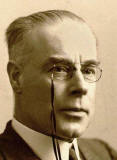|
Edward Drummond Young Some Impressions of American Photographic Methods |
|
Lecture to EPS The small photograph above of Edward Drummond Young was taken in 1933, about thirty years after he returned from working in America. It was on 2nd December 1903 that Edward gave a lecture to Edinburgh Photographic Society, entitled: "Some Impressions of American Photographic Methods" The paper covered his two years' residence in America. He spent over a year in upper Michigan and travelled about 6,000 miles. He explained that he would give an account of his own experiences which may not be typical of the whole of America. He added that changes happen quickly in America and that some of the practices he saw may no longer be current. |
|
Edward's comments on America included the following points: Experiences in Chicago - Photographers in America work longer hours and work on Saturday afternoons - The first of his four positions during his five months in Chicago was with a carbon printer, "a smart man who had not read a great deal about carbon printing".
- When asked why he described plate sizes with the largest
dimension first. (e.g. '5 x 4' ) for what in America would be described as
'4 x 5', Edward said he had replied: - An American photographer never forgets that it is the prints that he gives to his customers. Everything is done to make the negative perfect. Nothing is left to be done on the print. - A great deal of retouching is piecework and a really smart re-toucher working hard could make $20 to $25 a week, provided he got the work. - All the time I was in America, I never saw a double transfer carbon. I did one myself one day, just as a novelty. - The most popular printing paper was a matte collodion, toned first in gold then in platinum. Experiences in Iowa - The American photographers owe the Aristo Company a debt of gratitude. The company had made it their business that anybody buying their products got the best possible results. He spoke one occasion when the company's representative had travelled 300 miles to Iowa to assist him, when he had bought a bad batch of paper. Experiences in Upper Michigan - In one place, there was just the proprietor, myself and a girl in the reception room. We turned put from 500 to 700 prints a week, aristo and platinotype.
- From Monday to Thursday forenoon, there was nothing but
re-touching. The developing then was done before breakfast. - The retouching ranged from cabinet full length to 10 x 8 heads. With a good light, a soft pencil and sitting well back from the negative, it was possible to get through about 18 mixed negatives between about 8am and 6pm, thirty minutes for dinner. - We made matte cabinets for $4 a dozen and glossy (chloride paper) for £$3 a dozen for one position, 50 cents extra for two positions. Matte prints got as high as $6 by mounting on different mounts. We took $1 deposit. - Being in a mining town, there was every nation in Europe and a good few from Asia. Italian customers were in the majority, most bargaining over the prices. When the price was settled, the name and dollar had to be got. The dollar was easier. - I don't want to make out that this was all artistic photography because a large number of the sitters insisted in having completely in view two feet, two hands and five fingers on each hand. General Comments - Everybody in America gets photographed frequently, once a year and many much oftener. - A surprising thing is the way in which a man who has really no artistic sense picks up the knack of making almost artistic work; they seem to be able to get the thing down to a few rules and apply them. - A characteristic of American photographers that impressed me was their readiness to talk of their business. The American photographer strikes me, when you meet him at a convention as an enthusiastic jolly good fellow, friendly, and ready to do a good turn if in his power. - I saw much good work, both artistically and technically from all parts of the country. Among a certain set, their portraits must always be "snappy" in character. I must say personally I like a clean bright print, but those "snappy" portraits were a bit too much, nothing restful. They will soon be, if not now, very much the exception. - One thing that is good in a way for our American friend is the constant demand for something new; he doesn't get chance to get fixed much on a style of work, and can't live on a reputation without doing a good deal to keep it up. - It has been said that American photographs are not permanent. "What does that matter?" said one printer, "The folks who get them stick them in an album and forget all about them in a week, and six months later, they come back and re-sit." But that is changing rapidly. There is a big wave of artistic feeling sweeping the country. This will result in more artistic results and a desire to preserve them. |
|
[Transactions of Edinburgh Photographic Society, January 1904, pp.45-51] |
